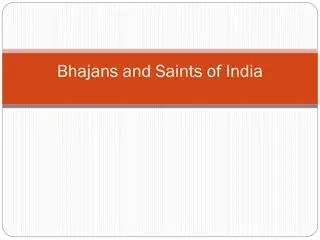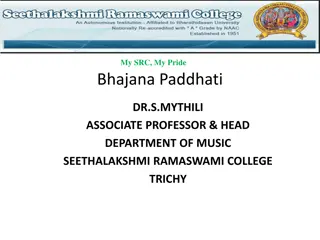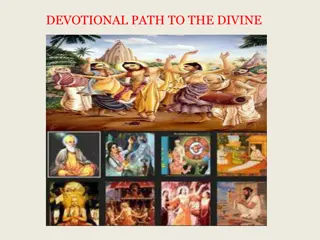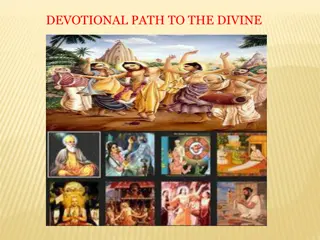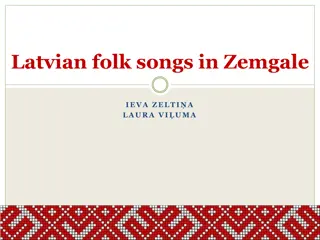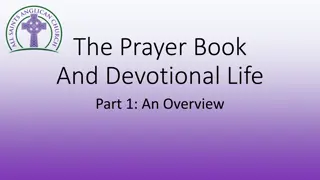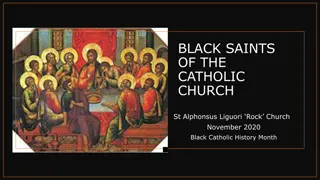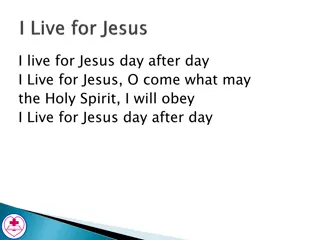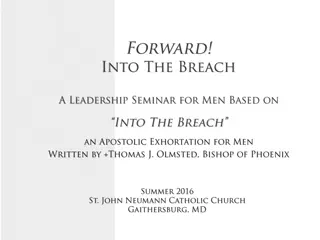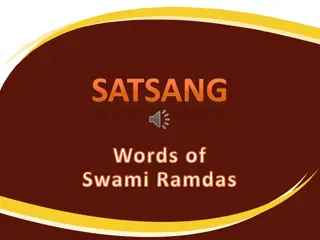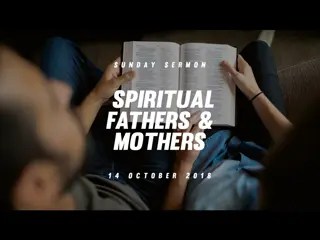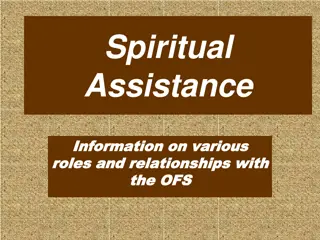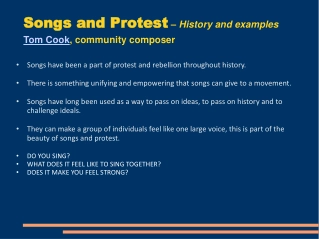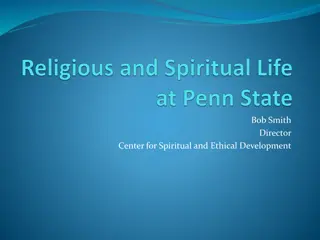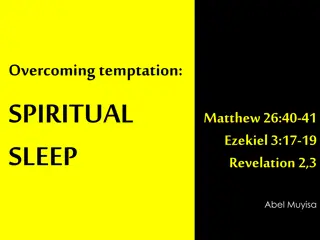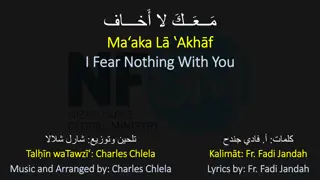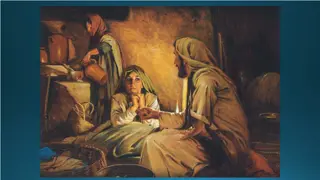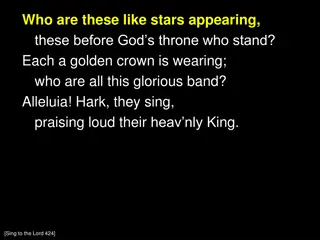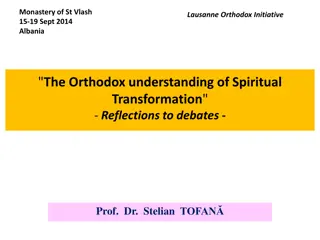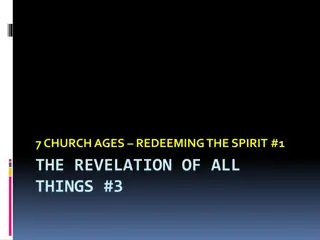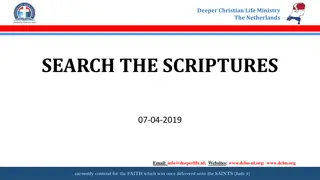Bhajans and Saints of India: Exploring Devotional Songs and Spiritual Figures
Bhajans are Indian devotional songs expressing love for the Divine. They come in various forms, ranging from simple mantras to complex compositions. Saints like Surdas, Tulsidas, and Meerabai composed bhajans, reflecting their spiritual connection. The epic Ramayana, written by Saint Valmiki, narrates the life events of Lord Rama. Valmiki's transformation from a robber to a revered sage showcases the power of redemption in Hindu mythology.
Download Presentation

Please find below an Image/Link to download the presentation.
The content on the website is provided AS IS for your information and personal use only. It may not be sold, licensed, or shared on other websites without obtaining consent from the author. Download presentation by click this link. If you encounter any issues during the download, it is possible that the publisher has removed the file from their server.
E N D
Presentation Transcript
BHAA = LORD, BHAGAWAAN, LIGHT, TRUTH, HAPPINESS GAWAT = SINGING BHAAGAWAT = BHAJAN
What is a Bhajan A Bhajan is any type of Indian devotional song. It is normally lyrical, expressing love for the Divine or God. It has no fixed form: it may be as simple as a mantra, shlok or kirtan or as sophisticated as the dhrupad or kriti with music based on classical ragas and talas. Anecdotes and episodes from scriptures, the teachings of saints and descriptions of gods have all been the subject of bhajans.
Saints who sang Bahajans The term "Sant" is derived from the Sanskrit word sat ( ) (truth, reality). The root meaning of the term Sant being "one who knows the truth" or "one who has experienced Ultimate Reality". Many of the saints were composers of Bhajans Surdas, Tulsidas, Meerabai, Nanak, Kabir, Chaitanya Mahaprabhu and Tyagaraja are few of the notable composers.
Saint Valmiki Ramayana the great epic of Hinduism is written by Saint Valmiki. The epic Ramayana is divided into several major kandas or parts, The chronological major events in the life of Lord Rama 1) Bala kanda, includes the birth of Rama. 2) Ayodhya Kanda, preparations for Rama's crowning and his exile into forest. 3) Aranya Kanda, forest life of Rama and kidnapping of Sita by Ravana. 4) Kishkinda Kanda, the meeting of Hanuman and Sugriva with Rama. 5) Sundara Kanda, the efforts of Hanuman, flight to Lanka and meeting with Sita. 6) Yuddha Kanda, the battle between Lord Rama and Ravana. 7) Uttara Kanda. the birth of Lava and Kusha to Sita. Final departures of Sita and Rama.
Story of Saint Valmiki Valmiki rishi was previously known as "Valya", the robber. In the past life he was very cruel and sinner.He killed people for money and belongings.For each living being killed by him he used to put one stone in a mud-pot. Such seven mud-pots ware filled by his sins. One day Maharishi (Great Saint) Narad was passing through a forest where "Valya" was looting the people."Valya" stopped Narada and holding a axe on his throat demanded for his money and gold belongings with him. Narada said "Dear I am a poor devotee of lord Narayana. I only have this clothes which I am wearing. Don't " kill me.I don't have wealth to give you.You have killed so many people and animals that that would take you to hell to pacify these sins.You think that you are doing this for your family. Please go and ask them if the are willing to partner you in the hell for these sins. After listening to Narada "Valya" went to his family and asked the same to his family. But no one got ready to partner in his sins.Not his wife,children or parents. Very depressed "Valya" came back to Narada and wit folded hands requested Narada "No one is ready to share my sins. Please tell me the way to get rid of these sorrows. Whatever you say , I wil follow your words." Narada said "OK, now surrender yourself to Narayana god and keep chanting his name . this is the only way to get rid of your sins. I'll give you the Mantra (The name of god to chant) . Continuously chant this mantra with whole-heartedness and you will attain the peace and godliness." Narada then gave him the Mantra. he asked valya to chant "MaRa". Actually "MaRa" is not a god's name ; but continuous chanting creates the sound of god's name as "RaMa" . After that Narada went from there and Valya started chanting the mantra as "MaRaMaRaMaRa.....".This mantra changed Valya's life permanently. After few days Narada came to see the progress of Valya. Now valya has become the knowledgeable and peaceful saint. Narada gave him the name "Valmiki". From then Valya is known as "Maharishi Valmiki". Valmiki wrote the great epic of Lord Rama known as the Ramayana.
Adi Sankara Adi (788 CE - 820 CE[1]), also known as a kara, was an Indian philosopher who consolidated the doctrine of Advaita Vedanta, a sub- school of Vedanta. He hailed from Kalady of present day Kerala. File:Raja Ravi Varma - Sankaracharya.jpg Shankara travelled across India and other parts of South Asia to propagate his philosophy through discourses and debates with other thinkers. He founded four mathas ("monasteries"), which helped in the historical development, revival and spread of Advaita Vedanta. Shankara himself is attributed to composing the popular 8th century Hindu devotional composition Bhaja Govindam (literal meaning, "Worship Govinda"). This work of Adi Shankara is considered as a good summary of Advaita Vedanta and underscores the view that devotion to God, Govinda, is not only an important part of general spirituality, but the concluding verse drives through the message of Shankara: "Worship Govinda, worship Govinda, worship Govinda, Oh fool! Other than chanting the Lord's names, there is no other way to cross the life's ocean".
Bhaja Govindam 1. bhajagovindaM bhajagovindaM govindaM bhajamuuDhamate . saMpraapte sannihite kaale nahi nahi rakshati DukR^iJNkaraNe Worship Govinda, Worship Govinda, Worship Govinda. Oh fool ! Rules of Grammar will not save you at the time of your death. 2. mUDha jahiihi dhanaagamatR^ishhNaaM kuru sadbuddhiM manasi vitR^ishhNaam.h . yallabhase nijakarmopaattaM vittaM tena vinodaya chittam.h Give up your thirst to amass wealth, devote your mind to thoughts to the Real. Be content with what comes through actions already performed in the past.
Meerabai Meerabai (Rajasthani: ) (c.1498- c.1547AD) was an aristocratic Hindu mystical singer devotee of lord Krishna from Rajasthan and one of the most significant figures of the Sant tradition of the Vaishnava bhakti movement. Some 12-1300 prayerful songs or bhajans attributed to her are popular throughout India and have been published in several translations worldwide. In the bhakti tradition, they are in passionate praise of lord Krishna. Meera's songs are in a simple form called a pada (verse), a term used for a small spiritual song, usually composed in simple rhythms with a repeating refrain, collected in her Padavali.
Meerabai Bhajan Paayoji Maine Shyaam Ratan Dhan Paayo ... Paayoji maine shyaam ratan dhan paayo - 2 Janam janam ki punji paayi, Jag me sabhi khovaayo, Paayoji maine shyaam ratan dhan paayo - 2 Kharch na laage koi chor na loote, Din din hot savaayo, Paayoji maine shyaam ratan dhan paayo - 2 Satki naav khevaaya sat guru, Kari kripa apanaayo, Paayoji maine shyaam ratan dhan paayo - 2 Mira ke prabhu giridhar nagar, Harshi harshi jas gaayo, Paayoji maine shyaam ratan dhan paayo 2 1) I have found, yes, I have found the wealth of the gem of chanting the Holy Name. 2) My true spiritual master gave me a priceless thing. With his grace, I accepted it. 3) I found the treasure of my several births; I have lost the whole rest of the world. 4) No one can spend it, no one can steal it. Day by day it increases one and a quarter times. 5) On the boat of truth, the boatman was my true guru. I came across the ocean of existence. 6) The Lord of Mira Bai is the Courtly Lord Giridhara, of whom I merrily, merrily sing His glories.
Swami Vivekananda Swami Vivekananda was the chief disciple of the 19th century saint Ramakrishna Paramahansa and the founder of the Ramakrishna Math and the Ramakrishna Mission.[ Vivekananda is considered to be a major force in the revival of Hinduism in modern India. He is perhaps best known for his inspiring speech which began: "Sisters and Brothers of America through which he introduced Hinduism at the Parliament of the World's Religions in Chicago in 1893. Swami Vivekananda was born in an aristocratic Bengali kayastha family of Calcutta on 12 January 1863. Vivekananda's parents influenced his thinking his father by his rationality and his mother by her religious temperament. From his childhood, he showed an inclination towards spirituality and God realization. His guru, Ramakrishna, taught him Advaita Vedanta (non-dualism); that all religions are true and that service to man was the most effective worship of God. After the death of his Guru, Vivekananda became a wandering monk, touring the Indian subcontinent and acquiring first-hand knowledge of conditions in India. He later travelled to Chicago and represented India as a delegate in the 1893 Parliament of World Religions. He conducted hundreds of public and private lectures and classes, disseminating Vedanta and Yoga in America, England and Europe. He also established the Vedanta societies in America and England. File:Vivekananda Memorial - Kanyakumari - India.JPG Vivekananda Temple on Vivekananda rock at Kanyakumari, India
Swami Vivekanandas Teachings Swami Vivekananda believed that the essence of Hinduism was best expressed in the Vedanta philosophy, based on the interpretation of Adi Shankara. He summarized the Vedanta's teachings as follows: Each soul is potentially divine The goal is to manifest this Divinity within by controlling nature, external and internal Do this either by work, or worship, or mental discipline, or philosophy by one, or more, or all of these and be free This is the whole of religion. Doctrines, or dogmas, or rituals, or books, or temples, or forms, are but secondary details. Vivekananda advised his followers to be holy, unselfish and have shraddha (faith). Vivekananda advocated to test thoroughly before making your decision of accepting or denying something: What little I know I will tell you. So far as I can reason it out I will do so, but as to what I do not know I will simply tell you what the books say. It is wrong to believe blindly. You must exercise your own reason and judgment; you must practice, and see whether these things happen or not. Just as you would take up any other science, exactly in the same manner you should take up this science for study. In his paper read at the World Parliament of Religions, Chicago (1893), Vivekananda also hinted about the final goal of physics.
Goswami Tulsidas Tulsidas (also Tulasidas, Gosv m Tuls d s, Tulas D sa) (1532 1623) Devan gar : ) was a great Awadhi bhakta (devotee), philosopher, composer, and the author of Ramcharitmanas, an epic poem and scripture devoted to the Hindu God Rama. Ramacharitamanasa, an epic devoted to Rama, was the Awadhi version of Ramayana of Valmiki. Like many translations of the original Sanskrit Ramayana, it is read and worshipped with great reverence in many Hindu homes in India. It is an inspiring book that contains couplets in verse form called chaupai. He also wrote Hanuman Chalisa The most famous Bhajan of Tulsidasa: Shree Ramachandra Kripalu Bhajaman
Raghupathi Raghav RaajaRam (A favorite Bhajan of Mahatma Gandhi) raghupati raaghav raajaaraam, patit paavan sitaram siitaaraam sitaram, bhaj pyaare tu sitaram iishvar Allah tero naam, sab ko sanmati de bhagavaan
Vaishnav Jan To Vaishnav jan to is a Hindu hymn in Gujarati which was composed by the 15th century poet-saint Narsinh Mehta. It was a favorite hymn of Mahatma Gandhi. WaishNawa jan to tene kahiye, je peed paraayee jaNe re He is the true Vaishnava who knows and feels another's woes as his own. Par dukkhe upkar kare toye, man abhiman na aaNe re While he serves those who are suffering, he does not entertain pride in his mind about it. SakaL lok maan sahune vande, nindaa na kare keni re He respects everyone, and denounces nobody. Waach-kaachch-man nischal raakhe, dhan dhan janani teni re He keeps his speech, deeds, and thoughts pure; blessed is his mother. Sam-drushti ne trishNaa tyaagi, parastree jene maat re Viewing all equally, he rids himself of covetousness, and reveres every woman as though she were his mother. Jihwaa thake, asatya na bole, par-dhan nava jhaale haath re His tongue would fail him if he were to attempt to speak an untruth. He does not covet another person's wealth. Moh-maayaa wyaape nahin jene, draDh wairagya jena manmaa re Material attachments do not occupy his mind, it being deeply rooted in renunciation. Raam-naam shu taaLE laagi, sakaL teerath tena tanmaa re Every moment he is intent on reciting the name of Rama. All the holy places are ever present in his body. WaNa lobhi ne kapat rahit chhe, kaam krodh nivaarya re He has conquered greed, deceit, lust, and anger. BhaNe Narsaiyyo tenu darshan karata, kuL ekoter tarya re Says Narasi, the sight of such a Vaishnava saves a family through seventy-one generations.
Tyagaraja Kakarla Tyagabrahmam (May 4, 1767 - January 6, 1847), colloquially known as Ty gar ja (Telugu: ) and Tyagayya was one of the greatest composers of Carnatic music or classical South Indian music. He, along with his contemporaries Muthuswami Dikshitar and Shyama Shastry, forms the Trinity of Carnatic music. He was a prolific composer and highly influential in the development of the South Indian classical music tradition. Tyagaraja composed thousands of devotional compositions, most of them in praise of Lord Rama. His compositions remain very popular even today. Of special mention are five of his compositions called the Pancharatna Krithis(English: 'five gems'), which are often sung in programs in his honour. http://upload.wikimedia.org/wikipedia/commons/thumb/c/c1/Tyagaraja.jpg/220px-Tyagaraja.jpg
Sant Tukaram Sant Tukaram was a devotee of god Vitthala or Vithoba, a form of Krishna. Tukaram's public religious discourses (" ") used to be mixed, by tradition, with poetry, which included some of his own compositions. His discourses focussed on day-to-day behavior of human beings, and he emphasized that the true expression of religion was in a person's love for his fellow human beings rather than in ritualistic observance of religious orthodoxy, including mechanical study of the Vedas. Like Namdev, Janabai, and Eknath, Tukaram wrote in archaic Marathi a large number of devotional poems identified in Marathi as abhang ( ). A collection of 4,500 abhang known as the G th is attributed to Tukaram. Mantra Geet , a Marathi translation in abhang form of the Sanskrit Bhagavad Geeta, is also attributed to him. It is an interpretation of Geeta from a Bhakti ( ) -- devotional perspective. Singing and chanting of God s glory was a surest path of god-realization to Tukaram. Perhaps attainment of inner purity and complete self-surrender enabled him to visualize God s presence and his abhangs attest that he felt god s presence every where and in everything


